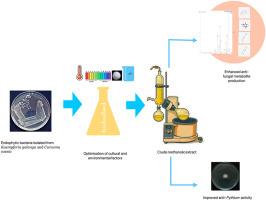Metabolic optimization of endophytic bacteria from aromatic ginger (Kaempferia galanga), and black turmeric (Curcuma caesia), for enhanced biocontrol of Pythium myriotylum
IF 3.3
3区 农林科学
Q2 PLANT SCIENCES
引用次数: 0
Abstract
Bioactive compounds from plant and microbial sources are known for their wide-ranging pharmaceutical properties, particularly antibacterial and antifungal effects. Secondary metabolite production is highly responsive to environmental variables. This study aimed to optimize nutritional and environmental conditions to optimize metabolite production by endophytic bacteria isolated from selected Zingiberaceae species, specifically for biocontrol of the soft rot pathogen Pythium myriotylum. Four isolates exhibiting in vitro anti-Pythium activity—Bacillus amyloliquefaciens CC11, B. pumilus KG6, Pseudacidovorax intermedius NCC15, and Rhizobium sp. NCC17—were selected for detailed analysis. The influence of carbon, nitrogen sources, minerals, pH, and temperature on bacterial growth and metabolite production was assessed. Among the tested strains, B. pumilus KG6 and P. intermedius NCC15 were identified as the most effective isolates, exhibiting the highest inhibition of P. myriotylum growth. Glucose significantly enhanced both biomass and metabolite yield, while sodium nitrate (NaNO3) and ammonium oxalate (NH4)2C2O4 further improved pathogen inhibition by B. pumilus strain KG6 and P. intermedius strain NCC15, respectively. The addition of the mineral salt dipotassium hydrogen phosphate (K2HPO4) was found to enhance the synthesis of bioactive metabolites. Optimization using Response Surface Methodology (RSM) revealed optimal conditions as pH 7 and an incubation temperature of 32 °C for B. pumilus KG6, and 31.7 °C for P. intermedius NCC15. In vitro validation of the model showed strong agreement between predicted and observed values. Comparative metabolomic analysis confirmed enhanced production of anti-Pythium compounds under optimized conditions. These findings underscore the critical role of specific nutrient sources in activating secondary metabolism and promoting the synthesis of bioactive compounds.

香姜(Kaempferia galanga)和黑姜黄(Curcuma caesia)内生细菌的代谢优化,以增强对霉病的生物防治
来自植物和微生物的生物活性化合物以其广泛的药物特性而闻名,特别是抗菌和抗真菌作用。次生代谢物的产生对环境变量有高度的反应。本研究旨在优化营养和环境条件,优化从姜科植物中分离得到的内生细菌对软腐病病原菌myriotyum的生物防治效果。选取了4株具有体外抑菌活性的分离菌株——解淀粉芽孢杆菌CC11、矮矮的芽孢杆菌KG6、中间假酸ovorax NCC15和根瘤菌sp. ncc17进行详细分析。评估了碳源、氮源、矿物质、pH值和温度对细菌生长和代谢物产生的影响。其中,矮矮化芽孢杆菌KG6和中间芽孢杆菌NCC15的抑菌效果最好,抑菌效果最好。葡萄糖显著提高了生物量和代谢物产量,而硝酸钠(NaNO3)和草酸铵(NH4)2C2O4分别进一步提高了矮螺旋藻菌株KG6和中间螺旋藻菌株NCC15对病原菌的抑制作用。发现矿物盐磷酸氢二钾(K2HPO4)的加入促进了生物活性代谢物的合成。利用响应面法(RSM)进行优化,发现矮矮的B. pumilus KG6和中间的P. intermedius NCC15的最佳培养条件为pH为7,培养温度为32°C和31.7°C。模型的体外验证表明,预测值和实测值之间的一致性很强。比较代谢组学分析证实,在优化的条件下,抗python化合物的产量增加。这些发现强调了特定营养来源在激活次生代谢和促进生物活性化合物合成中的关键作用。
本文章由计算机程序翻译,如有差异,请以英文原文为准。
求助全文
约1分钟内获得全文
求助全文
来源期刊
CiteScore
4.30
自引率
7.40%
发文量
130
审稿时长
38 days
期刊介绍:
Physiological and Molecular Plant Pathology provides an International forum for original research papers, reviews, and commentaries on all aspects of the molecular biology, biochemistry, physiology, histology and cytology, genetics and evolution of plant-microbe interactions.
Papers on all kinds of infective pathogen, including viruses, prokaryotes, fungi, and nematodes, as well as mutualistic organisms such as Rhizobium and mycorrhyzal fungi, are acceptable as long as they have a bearing on the interaction between pathogen and plant.

 求助内容:
求助内容: 应助结果提醒方式:
应助结果提醒方式:


